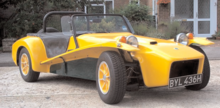Lotus Seven
The Lotus Seven wis a wee, semple, lichtweicht twa-seater open-top sports car produced bi Lotus Caurs (initially cried Lotus Engineering) atween 1957 an 1972.
It wis designed bi Lotus foonder Colin Chapman an haes been considered the embodiment o the Lotus philosophy o performance throu law weicht an simplicity. The oreeginal model wis heich sonsie wi mair nor 2,500 caurs selt,
Efter Lotus ended production o the Seven, Caterham bocht the richts tae it, an thir days mak baith kits an fully assembled caurs based on the oreeginal design.
The Lotus Seven design haes spawned a host o imitations on the kit caur mercat, generally cried Sevens or sevenesque roadsters. Mony o thae caurs is still produced the day. Alang wi manufacturer supplied kits, thare entirely self-biggit sevenesque caurs that is referred tae as Locosts
Heestory[eedit | eedit soorce]



The Lotus Seven wis launched in 1957, efter the Lotus Eleven wis in leemitit production. The Seven name wis lef, due tae a model that wis abandoned bi Lotus; a caur that wad hae seen Lotus enterin Formula Two wi a Riley-engined single-seater in 1952 or 1953. Housomever, the caur wis complete aroond Chapman's chassis as a sports caur bi its backers an christened the Clairmonte Special.
Based on Chapman's first series-produced Lotus Mark VI, the Seven wis pouered bi a 40 bhp (30 kW; 41 PS) Ford Side-valve 1,172 cc engine. It wis mainly for lawer budget club racin on short tracks (750 motor club).
The Lotus Seven Series 2 (S2) follaed in 1960, an the Series 3 (S3) in 1968. In 1970, Lotus radically changed the shape o the caur tae creaut the slichtly mair conventional sized Series 4 (S4), wi a squarer fibreglass shell replacin maist o the aluminium bodywork. It offered some "luxuries" as standard an aw, lik an internal heater matrix. The S4 model wisnae widely welcomed, an Lotus selt few caurs. Whit is believed tae be the auldest o thae Series 4's survives tae this day, an can be seen maist weekends aroond Sussex an Kent. A familiar face at Lotus events up an doun the kintra, this wis the seicont Series 4 ever biggit, an haes pruiven critics o the S4 wrang; it's leuks agin better nor mony predicted, an its performance an reliability unsurpassed bi ony o the oreeginal Seven's.
The Breetish tax seestem o the time (Purchase Tax) meant the caur coud be supplied as a kit (kent as "completely knocked down" or CKD) athout attractin the tax surcharge that wad apply gif it wis selt in assembled form. Tax rules specified assembly instructions couldna be included, but in a teepical Chapman-inspired piece o lateral thinkin, thare wis nae rule kiverin the inclusion o disassembly instructions. Hence aw the enthusiast haed tae dae wis follae them in reverse.
Haein jyned the EEC on 1 Januar 1973, the UK haed tae abolish Purchase Tax an adopt VAT insteid. VAT disnae allou for concessions lik "CKD", sae the tax advantage o the kit-biggit Lotus Seven came tae an end. (Note that VAT daes allou for variable ratin an even zero-ratin o certaint goods an services; but the Govrenment still opt no tae indulge the kit-builder).
In 1973, Lotus decidit tae shed fully its "Breetish tax system"-inspired kit caur image an concentrate on limitit series motor racin caurs. As i o this plan, it selt the richts tae the Seven tae its anly remainin agents Caterham Cars. Efter a brief period producin the Series 4, includin assembly o the last "kits" supplied bi Lotus, Caterham introduced thair version o the Series 3, an hae been manufacturin an refinin this caur syne as the Caterham Seven.
| Wikimedia Commons haes media relatit tae Lotus Seven. |
